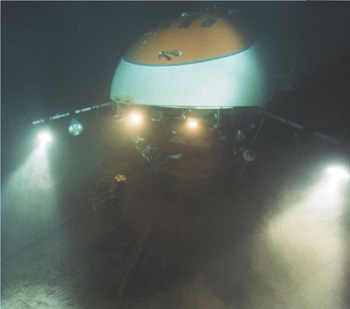Real-life Case Study: How Has Technology Affected Productivity?
Gross Domestic Product

Technology, according to Peter Zentz, “is the cornerstone of all the products we make.” Zentz is an executive with Benthos, Inc., a manufacturer of underwater equipment such as cameras that operate on the ocean floor. Benthos cameras took the first underwater pictures of the RMS Titanic after its discovery.
“The technology that continues to be developed in our industry,” says Zentz, “is truly remarkable. But what strikes me every day is the way in which other types of technology have enabled us … to efficiently serve our customers, communicate effectively with them and our workers … and keep precise records.”

High-tech underwater cameras help researchers study the ocean floor.
Teleconferencing Rick Gifford, a Benthos sales executive, believes that one of the greatest advancements for business is the technology that makes teleconferencing possible. “We used to spend hours, even days, bringing our sales representatives, customers, and field workers into our office for important meetings,” he explains. “Through teleconferencing we get it done just as effectively, eliminate enormous expense, and no one has to be uprooted.”
Photocopiers Zentz and Gifford, however, both agree that the computer is not their most indispensable technological device. “Believe it or not,” says Zentz, “we've found that the copy machine is our most important piece of equipment. The thought of hand-copying the thousands of designs, research reports, written correspondence, and other documents that we generate every year boggles my mind.”
Zentz is not alone in his opinion. In a recent survey, most office workers indicated that the photocopier is important to their productivity. But whatever the ranking, one thing is certain. Technology has changed the business world forever.
Applying Economic Ideas
- How has technology affected office productivity?
- The graph below shows the value of computers sold in the United States. What might this graph indicate about the growth of GDP in the late 1990s and early 2000s?
Table of Contents
- Section 1 Benefits of Free Enterprise
- Section 2 Promoting Growth and Stability
- Section 3 Providing Public Goods
- Section 4 Providing a Safety Net
- Real-life Case Study: Government and the Interstate Highway System
- Chapter 3 Assessment
- The Wall Street Journal. Classroom Edition Debating Current Issues: Health-Care Costs
- Section 1 Perfect Competition
- Section 2 Monopoly
- Section 3 Monopolistic Competition and Oligopoly
- Section 4 Regulation and Deregulation
- Real-life Case Study: Regulating Cable Television
- Chapter 7 Assessment
- The Wall Street Journal. Classroom Edition Debating Current Issues: Oil and Energy Dependence
- Section 1 Levels of Development
- Section 2 Issues in Development
- Section 3 Financing Development
- Section 4 Transitions to Free Enterprise
- Real-life Case Study: The World Bank and Economic Assistance
- Chapter 18 Assessment
- The Wall Street Journal. Classroom Edition Debating Current Issues: Tariffs and Trade





